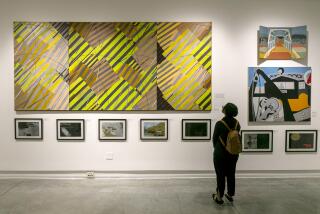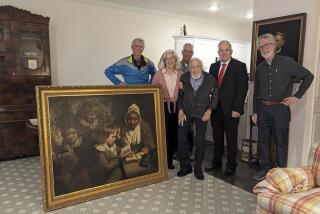Former UCLA Official Convicted of Stealing and Selling Painting
The former director of student counseling at UCLA was convicted in federal court Friday of stealing a 19th century oil painting from the university and selling it to a New York art gallery for $200,000.
Jane Crawford, who worked at the university 23 years, faces 18 to 24 months in prison when she is sentenced in November on four fraud counts.
Crawford, 50, was found guilty of stealing and selling “Frost Flowers, Ipswich 1889,” a landscape that hung in Murphy Hall, the campus administration building.
The painting is the work of Arthur Wesley Dow, a seminal figure in the American Arts and Crafts movement who was a mentor to Georgia O’Keeffe.
Dow’s widow donated nine of his paintings, including “Frost Flowers,” in 1928 to an association affiliated with UCLA’s art department.
The association was later dissolved and, according to Assistant U.S. Atty. Ranee A. Katzenstein, the paintings became the university’s property by default.
Crawford’s lawyer, Lawrence S. Strauss, argued that no crime occurred because UCLA had no clear-cut proof that it ever owned the painting.
The only proof produced by the government was an article in the Arthur Wesley Dow Assn. journal of 1928 that mentioned the gift. At that time, the school was still the southern branch of UC Berkeley.
A UCLA official testified that donor records were kept in Berkeley and were probably lost or discarded over time.
“Just because an institution doesn’t have a formal inventory for a valuable possession, it doesn’t mean an employee can walk off with it and sell it for their own benefit,” prosecutor Katzenstein said after the verdict.
Crawford, whom UCLA dismissed in April, did not testify or call any witnesses during the three-day jury trial in Los Angeles.
According to trial testimony, the painting hung unappreciated for many years in the office of the UCLA registrar, who handed it off to a member of Crawford’s staff, Craig Cunningham, in 1979.
Cunningham said he placed it on a wall in his office for a time but later took it home and hung it above a mantel until 1989, when he returned it to UCLA, putting it in a storage area that doubled as an employee break room. In retrospect it was wrong to have taken the painting home, though he never made a secret about it, he said.
Crawford’s attorney said employees in the counseling department used the painting in the break room as a “dartboard,” throwing pens and pencils at the canvas.
The painting next turned up hanging in Crawford’s office. Her lawyer told jurors that she believed it was a gift from Cunningham, a claim that her onetime colleague categorically denied.
Cunningham also testified that he was taken aback when Crawford told him she was thinking about selling the painting. He said he told her it wasn’t hers to sell.
Crawford sold the painting in 1994 through an acquaintance, Ken Weaver, now deceased, to the Spanierman Gallery in New York City for $200,000. The prosecution said she tried to hide her role in the sale by having Weaver represent himself as the painting’s legal owner and by arranging for the proceeds to be deposited into Weaver’s checking account.
Afterward, Weaver wrote checks to pay for Crawford’s personal needs, including credit card debts, private school tuition for her child and an escrow deposit, the prosecution said.
In 1996, Crawford and Weaver had a falling out. Weaver went to the Los Angeles Police Department, which launched an investigation. The FBI was brought into the case because it involved allegations of interstate theft.
In the meantime, the gallery had restored and sold the painting to a private collector for $317,000. The gallery, which was not accused of wrongdoing, returned the purchaser’s payment after learning of the investigation and surrendered the painting to the government.
The gallery is now suing both UCLA and Crawford in Los Angeles federal court for $14 million and to establish its legal title to the painting.
The gallery contends that UCLA failed to employ proper measures to safeguard the artwork from theft. UCLA denies the charge.
The painting will remain in the FBI’s custody until the civil suit is settled, Katzenstein said.
More to Read
Sign up for Essential California
The most important California stories and recommendations in your inbox every morning.
You may occasionally receive promotional content from the Los Angeles Times.










